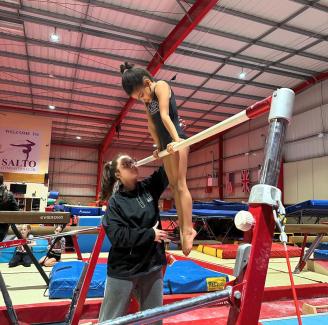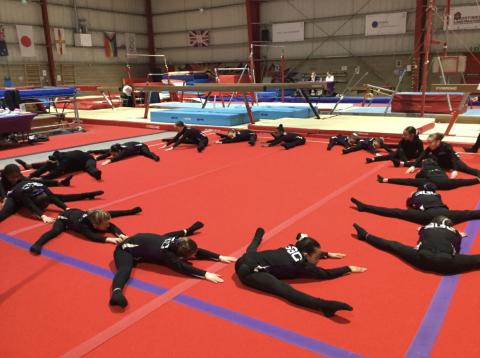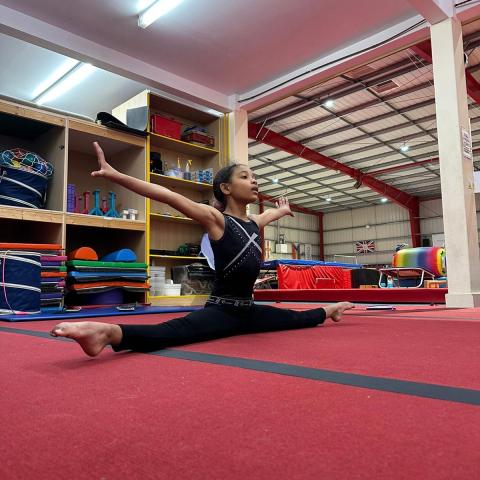Womens Artistic Gymnastics
Meet our Women's Artistic Department
|
Image

|
Image

|
Image

|
Women’s Artistic Gymnastics
Women’s Artistic Gymnastics is one of the most popular and captivating sports in the world. It combines athleticism, artistry, strength, and grace, as gymnasts perform on four apparatus — Vault, Uneven Bars, Balance Beam, and Floor Exercise — along with Range and Conditioning work throughout grades.
At SALTO Gymnastics Club, we pride ourselves on identifying and nurturing young talent from as early as 4 years old. Entry into our Women’s Artistic Squad is by selection only. Our qualified coaches continually scout for potential, looking for girls who demonstrate flexibility, coordination, strength, discipline, and character.
Following an initial assessment, each gymnast is placed in the appropriate training group to ensure the best development pathway. We value quality over quantity — our squad training allows for personalized coaching and long-term athlete growth. Entry into the program is based on the gymnast’s potential and our ability to help them progress effectively.
Competition Structure: Grades & FIG Development/Classic Challenge
The gymnastics year is divided into two key phases:
- Grades (First Half of the Year)
Gymnasts perform set routines designed to develop foundational skills at each level. - FIG Development/Classic Challenge (Second Half of the Year)
Gymnasts create personalized routines based on a set of required elements, allowing them to showcase their strengths and creativity.
A Foundation for Life and Sport
Only a small number of gymnasts possess the physical and emotional qualities needed to compete beyond club, county, or regional level. These include focus, determination, patience, competitive spirit, and a strong work ethic — all of which take years to develop.
We firmly believe that gymnastics training is never wasted. The discipline, coordination, and strength gained through the sport benefit athletes in countless other sporting and life pursuits.
What Makes It Special
The enduring fascination of Women’s Artistic Gymnastics lies in its ability to continually challenge and inspire. Each apparatus demands strength, control, endurance, and elegance, while fostering confidence, creativity, and courage.
Selection & Commitment
Gymnastics at this level isn’t suitable for every child, and our coaches are trained to assess suitability carefully. If we believe your child is ready for this pathway, a member of staff will contact you directly.
If you think your child may have the potential for competitive gymnastics but haven’t been approached, please contact us.
Membership in the Women’s Artistic Squad requires strong commitment from both gymnast and parent. Squad gymnasts range from 4 years and older, training between 4–20 hours per week, depending on their group and level.
Training Groups & Pathways
We offer a range of training groups and progression pathways tailored to each gymnast’s ability and goals. Trials are held approximately every six months.
If your child has previous experience in an artistic squad and you’d like to enquire about a trial or space, please email:
📧louisa@saltogym.org
WAG Coaches
Louisa Cuthbert – Level 3 WAG (Level 4 Pending assessment)
Hollie Chadwick – Level 1 WAG (Level 2 Pending assessment)
Lara Harker – Level 1 WAG (Level 2 Pending assessment)
Aisha Caruana – Level 1 WAG (Level 2 Pending assessment)
Contacts
For all Women’s Artistic Gymnastics (WAG) enquiries:
📩Louisa Cuthbert, Head of Discipline – louisa@saltogym.org
For general enquiries:
📩reception@saltogym.org
The Four Apparatus
Vault (VT)
Gymnasts sprint along a 25m runway, transfer their speed onto a springboard, and propel themselves onto the vault table. Using explosive power, they perform somersaults and twists before landing. A good vault shows height, distance, and control, with a clean, steady landing.
Uneven Bars (UB)
The bars stand at 170cm (low bar) and 250cm (high bar), with a maximum distance of 180cm between them. Routines feature continuous swinging movements, transitions, releases, and regrips — often including twists and somersaults. The best routines demonstrate fluidity, flight, and precision.
Balance Beam (BB)
Standing 1.25m high, 5m long, and only 10cm wide, the beam tests a gymnast’s balance, composure, and grace. Routines combine acrobatics, leaps, jumps, turns, and dance elements, covering the full length of the beam and concluding with a dynamic dismount.
Floor Exercise (FX)
Performed on a 12m x 12m spring floor, the routine blends dance, tumbling, and acrobatics to music. Each performance showcases expression, artistry, and technical skill, with varied tempo, direction, and mood throughout. Individuality and creativity are the heart of a great floor routine.
Check out all of our latest competitions/news by clicking here!
-
Popularised in the 70’s by elfin-like stars such as Olga Korbut and Nadia Comaneci, Women’s Artistic Gymnastics remains one of biggest crowd pleasers and most watched sports at the Olympic games.
It’s fascination and popularity amongst girls of all ages lies in it’s ability to provide constant challenge and teach body control, coordination, amplitude and courage.
It was the sport of choice for the UK’s most decorated gymnast, Beth Tweddle, who began the sport at an early age yet continues to thrill audiences the world over, with her ability to innovate and prove that age is no barrier to participation and success.
Women’s Artistic Gymnastics is the sport of choice for girls who love turning their world upside down, in more ways than one:-
Vault (VT)
Following apparatus innovation in early 2001, the vaulting horse has now been replaced with a wider vaulting table. It provides the perfect platform from which to launch sky high, before returning to earth with a controlled landing.Gymnasts approach the vault from a 25metre run, transfer their speed to the springboard and seek a quick hand placement to the table. From here the gymnast uses internal spring to launch themselves vertically for a combination of somersaults and twists. A good vault should land at least 2metres from the table and include no steps on landing
Uneven Bars (UB)
Like the men’s parallel bars the Uneven Bars provide double the challenge for gymnasts. The low bar is set around 170cm in height and the high bar often around 250cm. The distance between the two bars is set at a maximum of 180cm.
Swinging and continuous movements are required on this apparatus. Routines typically include movements in both directions as well as above and below the bars. Elements with twists and somersaults with multiple grip changes and high flight often are awarded with the highest scores. Like men’s horizontal bar, the wind up and dismount is often the most exciting part of the routine.
Balance Beam (BB)
Perhaps the most precarious piece of apparatus for girls, the beam stands 1.25metres from the floor, is five metres long and if that was not posing enough of a challenge, is only 10cm wide. That is the width of your average house brick!
A beam routine is an exercise in precision with no room for error. The gymnast performs a combination of acrobatic elements, leaps, jumps, turns, steps, waves and balance elements. These can be done standing, sitting or lying on the beam. It is a requirement that the gymnast uses the entire length of the beam, with routines concluding often with a series of acrobatic elements off the side or end of the beam.
Floor Exercise (FX)
The floor exercise allows the gymnast their moment in the spotlight and is considered by many to be the most expressive piece of women’s apparatus.
A floor routine, always accompanied by music, includes a combination of dance movements and sequences interspersed with a variety of tumbling and acrobatic elements. The whole floor area must be used in the routine with clear variances in mood, tempo and direction. Individuality, originality, and artistry of presentation are the key ingredients of a great routine.